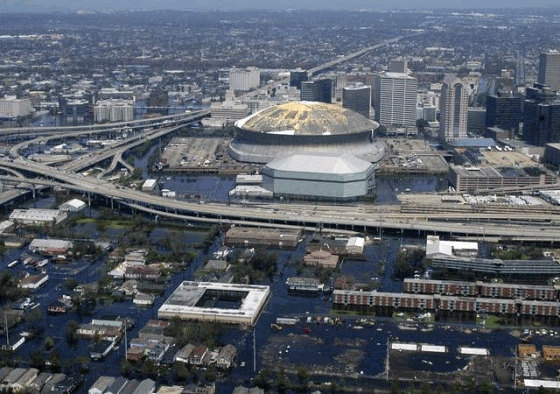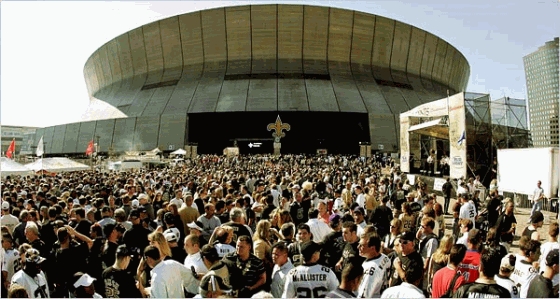|
Today in New Orleans History |
|
|
February 5


 On October
21, 2005, Benson issued a statement saying that he had not made any decision about the future of the Saints. The
San Antonio Express-News reported that sources close to the Saints' organization said that Benson planned to void his lease
agreement with New Orleans by declaring the Louisiana Superdome unusable. NFL Commissioner Paul Tagliabue met with
Benson and Louisiana governor Kathleen Blanco at the Saints' first home game in Baton Rouge on October 30 against the Miami
Dolphins. After the meeting Tagliabue said "The Saints are Louisiana's team and have been since the late '60s when
my predecessor Pete Rozelle welcomed them to the league as New Orleans' team and Louisiana's team. Our focus continues to
be on having the Saints in Louisiana." He dispelled rumors that had the Saints relocating to Los Angeles. Tagliabue
appointed an eight-owner advisory committee to help decide the team's future. Benson left the game with five minutes left
in the fourth quarter. A WWL-TV camera crew recorded him leaving the stadium. Benson angrily pushed the camera away and
then got into an argument with a fan. Three days later, Benson issued a statement that he would no longer go to Baton Rouge
for Saints home games because he felt he and his family were in danger from abuse at the game. The following day, Benson
agreed with Louisiana state officials to extend his opt out clause with the Superdome and Louisiana until January 2007. In the midst of the Katrina relocation controversy, several groups of investors approached Benson with offers to buy the
team and keep them in Louisiana, the most notable group being one led by Fox Sports analyst and former Pittsburgh Steelers
quarterback Terry Bradshaw, who is a Louisiana native. Benson expressed that he had no intention of selling the team and
planned to eventually hand down ownership to his granddaughter, Saints owner/executive Rita Benson LeBlanc. Benson spoke
to press following an NFL owners' meeting on November 15, during which he reiterated that the team is not for sale, but also
stated that other NFL owners, along with Tagliabue, were working with him to keep the team in New Orleans. Tagliabue said the team's preseason games would likely be played elsewhere in the region. He
also stated that the Saints and the NFL were committed to New Orleans for the long haul. Starting in the fall of 2006,
the Saints returned to playing all of their regular home games of the 2006 season in New Orleans at the Superdome. Their first
game back in New Orleans, on September 25, 2006, was marked by a dramatic blocked punt early in the first quarter, with Steve
Gleason blocking the punt and Curtis Deloatch recovering the ball in the Falcons' end zone for a touchdown. It was the first
score in the Saints' first game in New Orleans in nearly 21 months. The Saints won the game and, unexpectedly, went on to
have the most successful season in their history up to that time, reaching the NFC Championship Game for the first time in
franchise history.  

To receive an update for each day in New Orleans
history, join our facebook page
- Today in New Orleans History
Carnival Day was celebrated on February 5, 2008.
Photo of the construction of the "new" New Orleans Library Main Branch on Loyola Avenue on February 5, 1958. Several photos of the Carrollton Avenue Pontchartrain Expressway interchange on February 5, 1957. Several photos of St. Charles Avenue on February 5, 1950. Several photos of Nashville Avenue on February 5, 1950. Photo of 1550 Dufossat Street on February 5, 1950.
Ruth's Chris Steak House.owner Ruth Fertel was born February 5, 1927.
In February 1823, Jean Lafitte was cruising off the town of Omoa, Honduras on his
43-ton armed Colombian schooner named General Santander. Omoa was the site of the largest Spanish fort in Central
America, built to guard the Spanish silver shipments from the mines of Tegucigalpa to overseas destinations. Lafitte attempted
to take what appeared to be two Spanish merchant vessels on the night of February 4. It was cloudy with low visibility.
The Spanish ships appeared to be fleeing but, at 10:00 pm, turned back for a frontal counterattack against Lafitte's ship.
The Spanish ships were heavily armed privateers or warships and returned heavy fire. Wounded in the battle, Lafitte is believed
to have died just after dawn on February 5. He was buried at sea in the Gulf of Honduras. |
|
|

To receive an update for each day in New Orleans history,
join our facebook page - Today in New
Orleans History.
Analytics |
 The road back to the Dome post-Katrina was filled with controversy, innuendo, and rumor. Did owner Tom Benson want to
move the team to San Antonio? Did the NFL prefer to relocate the Saints to Los Angeles, or even to expand to Toronto
-- both cities over twice the size of San Antonio?
The road back to the Dome post-Katrina was filled with controversy, innuendo, and rumor. Did owner Tom Benson want to
move the team to San Antonio? Did the NFL prefer to relocate the Saints to Los Angeles, or even to expand to Toronto
-- both cities over twice the size of San Antonio? On December 5, Tagliabue met with Benson and New Orleans officials to tour the city and assess the viability of playing in
New Orleans in 2006. On January 11, 2006, at a press conference in New Orleans, Tagliabue announced that the Saints would
likely play all eight home games at the Superdome. Superdome officials said January 12 that the Dome would be ready by September
1, 2006. The NFL announced on February 5, 2006, that the Superdome would reopen on September 24 when the Saints were to host
the Atlanta Falcons.
On December 5, Tagliabue met with Benson and New Orleans officials to tour the city and assess the viability of playing in
New Orleans in 2006. On January 11, 2006, at a press conference in New Orleans, Tagliabue announced that the Saints would
likely play all eight home games at the Superdome. Superdome officials said January 12 that the Dome would be ready by September
1, 2006. The NFL announced on February 5, 2006, that the Superdome would reopen on September 24 when the Saints were to host
the Atlanta Falcons.
